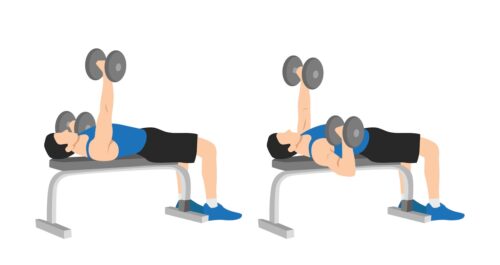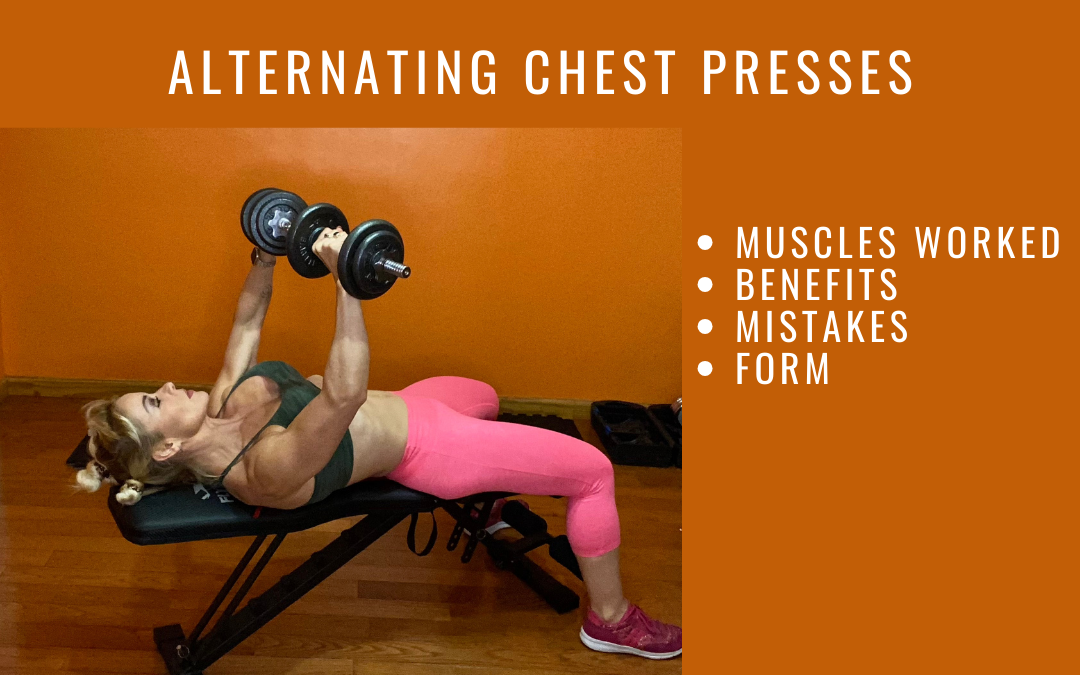The chest press is one of the top five exercises to develop your upper body and get in shape. A great variation of this exercise is the alternating chest press. This guide will teach you the muscles involved in alternating chest presses, the benefits and common mistakes associated with alternating chest presses, how to perform the alternating chest press properly, and give you ideas to complete your chest workout.
What Muscles Do Alternating Chest Presses Work?
Primary Muscles:
- Chest Muscles: These are the pectorals, which are divided into the pectoralis major and pectoralis minor. The pectoralis major is the larger one, a fan-shaped muscle comprising most of the chest wall. It keeps your arms attached to your body and is involved in adduction and internal rotation of the arm on the shoulder joint, as well as flapping, pressing, and lifting movements. The pectoralis minor is smaller and flatter. This one lies underneath the pectoralis major and is involved in shoulder functioning.
Secondary Muscles:
- Triceps Brachii: The name triceps is due to the fact that these muscles are composed of three muscle strands (the long, medial, and lateral heads). It specifically targets the long head of the tricep. The triceps are involved in forearm and elbow extension, helping extend or straighten the elbow. They are also involved in shoulder adduction and extension, helping pull the arms down. Additionally, the triceps help to stabilize the shoulder joint. Close grip presses target all three heads of the muscle, especially the long head.
- Deltoids: These are the main shoulder muscles. The anterior deltoid flexes and medially rotates the arm, the lateral deltoid abducts the arm, and the posterior deltoid extends and laterally rotates the arm. The anterior deltoids are very active in close-grip dumbbell presses and much more in an incline position.
- Rotator Cuff: A group of muscles and tendons that surround the shoulder joint (supraspinatus, infraspinatus, teres minor, and subscapularis) and are responsible for stabilizing your shoulder joint.
- Erector Spinae (spinal erectors): These muscles run along the length of the spine, from the sacrum and hips to the base of the skull, and make up most of the lower back. They straighten, rotate, and stabilize the back, and along with the glutes help maintain good posture. The spinalis muscle is the smallest and closest to the spine, the longissimus muscle is the intermediate and the largest of the three columns, and the iliocostalis is the outer muscle of the erector spinae.
- Serratus Anterior: Muscles on the upper sides of the torso that wrap the rib cage. The main part lies deep under the scapula and the pectoral muscles – in between the pectoralis major and latissimus dorsi muscles. They rotate and draw the scapula anterolaterally.
- Coracobrachialis: Long muscles of the anterior compartment of the arm – deep muscles of the chest and front of the arm, with the boundaries of the axilla. They extend from the coracoid process of the scapula to the shaft of the humerus. Their function is flexion and adduction of the arm at the shoulder joint.
- Trapezius: These diamond-shaped muscles extend from the top of the neck to the shoulder and down toward the mid-back. They attach to the skull, vertebral column, and shoulder girdle. They are involved in the movements of the shoulder girdle.
Alternating Chest Press Benefits
After learning the muscles involved in alternating chest presses, let’s look at the vast benefits associated with the exercise:
- Strength: The alternating chest press not only makes your chest muscles stronger but multiple upper body muscles, as well as your abs.
- Calorie Burner: The alternating chest press is a multi-joint exercise encompassing upper body muscles, which helps you burn more calories and consequently more body fat.
- Aesthetics: This exercise helps mold a great upper body. It helps lift the chest – for males and for females – and sculpts shoulders and arms.
- Joint Stability: Besides working your chest muscles, alternating chest presses work your stabilizer muscles. This helps keep your primary muscles stable during the movement as well as your joints.
- Imbalance Correction: This alternating exercise involves a unilateral movement, engaging one arm at a time. This helps correct upper body weaknesses and imbalances, which can take place due to overcompensating on one side of the body.
- Injury Prevention: Having stable joints and balanced muscle groups helps prevent injuries.
- Simplicity: Alternating chest presses can be performed by anyone, at any age, or any fitness level. The only equipment needed is a bench and a set of dumbbells. But if you don’t have a bench, you can perform the exercise on the floor. Additionally, you can perform this exercise with resistance bands – as with the band chest press.
- Healthier Bones: Alternating chest presses like other resistance training exercises support bone health and help prevent osteoporosis.
How to do Alternating Chest Presses

- Grab a set of dumbbells and lie on the bench or floor.
- If using a bench, plant your feet flat on the floor and relatively wide apart. It’s best to have your feet planted on the floor rather than placing them on the bench, so you are more stable.
- Keep a neutral spine with your butt, shoulders, and head flat on the bench.
- As you exhale, press the dumbbells up, extending the arms perpendicularly to your body. The weights should be above the chest, a bit wider than shoulder-width apart, but without locking the elbows.
- As you inhale, keep one dumbbell in place with the arm extended and lower the other dumbbell slowly.
- Exhale as you push that weight back up.
- Do the same thing with the other arm.
- Keep alternating, repeating the movement for 8 to 12 repetitions and for 3 sets. Perform 2 to 6 sets of 6 or fewer reps if you are looking to gain strength.
- Once you’ve finished your reps, put the weights on the floor.
? Start using a weight that you can comfortably lift for 12 reps and three sets. Once you perform this exercise safely and with proper form, you can increase the weight.
? If you have shoulder injuries, you should avoid this exercise. If you experience any sharp pain during the bench press, stop the exercise immediately.
Alternating Chest Press Mistakes
- Moving the Dumbbells Toward the Neck: The path of the dumbbells shouldn’t be over the head/neck area. This is unsafe and dangerous and removes the emphasis away from the chest muscles. You should keep the dumbbells at chest level.
- Improper Grip: Moving the dumbbells much wider than shoulder-width apart keeps your elbows too flared out, risking injury to your pectoral muscles or deltoids. Moving the dumbbells too close together targets the triceps much more – so you would be performing close grip presses instead. Your grip on the dumbbells should normally be slightly wider than shoulder-width apart so that your elbow joints and forearms are in a perpendicular plane.
- Locking Your Elbows: Avoid locking the elbows out explosively or locking them at the top. You risk injuring your elbows or shoulder joints.
- Pressing Your Head into the Bench: Pushing your head into the bench to help move the weight up stresses the neck muscles instead of the intended chest muscles. Keep your head flat on the bench without pressing down.
- Lifting Your Butt: Elevating the buttocks during the movement strains the lower back. Your butt should remain flat on the bench while pressing.
Alternating Chest Presses Video Tutorial
Chest Workout
You can complete your chest workout by performing the following exercises:
As you can see, the alternating chest press is a wonderful upper-body exercise. It offers numerous benefits associated with hypertrophy, improved performance, imbalance correction, and overall health. Now that you know how to properly perform alternating chest presses, you can avoid the most common mistakes and enjoy their benefits.
Lift, Burn more Fat, Get Stronger, and Live Healthier!
To a Fitter Healthier You,
The Fitness Wellness Mentor



